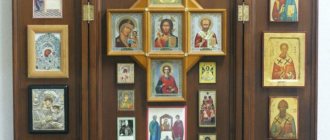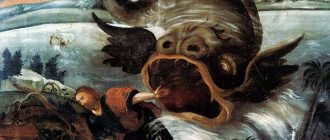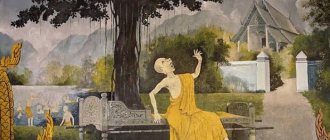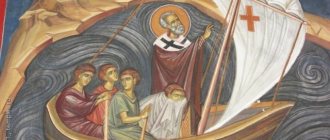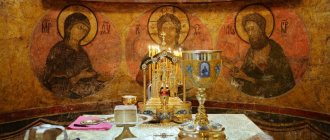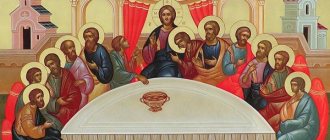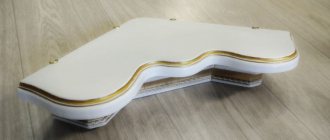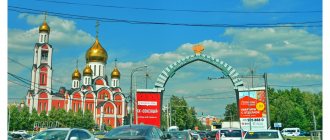The hut is red in the corners! – this is what the Russian proverb says. Not every modern person will understand what folk wisdom is talking about. And the meaning of the proverb is that the most beautiful thing in a house is not the furniture and carpets, but the corner where the holy faces are located.
A home iconostasis is a temple corner where a believer can retire with his thoughts and talk with his intercessor angel. Creating a place of worship is a responsible and God-pleasing matter, so you need to approach the organization of an icon display with knowledge of the matter.
History of the red corner
Home iconostases appeared in Ancient Rus'. A whole corner was set aside for them, which was called red (i.e. beautiful). In this place, icons were placed, candles and lamps were lit. In the morning and evening, as well as at times of special spiritual need, household members said their prayers here.
The iconostasis of those times was a multi-tiered shelf on which a god was hung - a small curtain that covered the images of saints and the Savior on the sides. The icons were hidden under the gospel - a special cloth that was pulled back only during prayer. It was no coincidence that such a tradition appeared in Rus'. It is known that the first image of the Savior would have been created by Himself, according to His will of God: after Jesus sprinkled his face with water and wiped it with ubrus (cloth), His face remained on this canvas. He sent this painting to the sick ruler of Asia Minor, Abgar, thanks to which he was healed. After this, the prince gave the order to nail the sacred board over the gates of the city. After 900 years, the sacred image was transferred to Constantinople. Now every year on August 29, Orthodox Christians celebrate the feast of the discovery of the image of the Savior Not Made by Hands and consecrate hand-woven fabrics.
What else was placed on the shelf for images?
Home iconostasis of those times were also intended for storing holy water and prosphora. The household hid the Gospel and memorial books (special books in which the names of all the deceased and living Orthodox Christians of this family were kept) behind the god. Particularly skilled needlewomen created doves (as a symbol of the Holy Spirit) from scrap materials and hung them from the iconostasis. In the red corner it was obligatory to have lamps and candles, which were lit during home services.
A similar small temple was in every Orthodox home until the 1917 revolution. After the Bolsheviks came to power, people continued to pray, but they did it in secret. Therefore, from the richly decorated home iconostases, only a few images remained, which people carefully hid from prying eyes, fearing persecution. The modern red corner is somewhat different from the one created by our ancestors, since many of the traditions of its creation have simply been forgotten.
Create your own red corner
What the home iconostasis will be like depends only on the owners of the house. However, remember to follow the following rules:
- Holy images must be installed far from technology (TV, computer, etc.) - the farther from everything worldly, the better.
- There should be enough space in front of the icons so that those praying do not feel crowded. And during prayer, it is better to place church books (prayer books, the Gospel) on a folding lectern (stand).
- You should not place icons individually on bookshelves, in cabinets, while crowding these images with other worldly objects: souvenirs, pictures, etc. This is strictly prohibited, since by doing so we show disrespect for God. After all, for some reason, many people put photographs of people we love and care about, especially those who have left this world, in the most prominent place, without cluttering them with unnecessary objects. The same should be done with icons, showing love and respect for holy images.
The difference between icons and paintings
If you have reproductions of paintings at home that reflect biblical scenes, you should not install them on the iconostasis.
The main difference between a holy image and painting is that in the first case, through icons we communicate with the Lord. And since the iconostasis is a sacred place intended for solitude in prayer, the inclusion of reproductions in it would be simply inappropriate.
Icons cannot be hung on the wall next to posters of celebrities - by doing this we insult holy images, putting them on a par with earthly idols.
It is better to place home iconostases in the eastern part of the house, since this part of the world has special significance in Orthodoxy.
For example, from the Old Testament it is known that the Lord created a paradise for people in the eastern part of Eden. And the Gospel says that just as lightning comes from the east to the very west, so the Lord comes from Heaven. The church altar is also located in the eastern part. If the windows face this side, the home iconostasis, a photo of which you will find in this article, is installed in any other suitable place.
Transfiguration Cathedral, Uglich (Yaroslavl region):
There is a rare six-tiered iconostasis created in 1853. The images on it are arranged according to the canons of the hierarchy of the Heavenly Church: from local ranks to the Prophets. There are 60 icons in total. The classic layout of the subjects was collected from icons of the 17th-18th centuries.
Most of the iconostasis was created by the Moscow master F. Rozhnov. The details of some icons that are not typical of the classical school attract attention: small floral patterns on clothes, elaborate backgrounds, “secular” faces. These are echoes of the Ukrainian Baroque style.
The iconostasis is framed by luxurious carved gilded decor. It is noteworthy that the frame is much younger than the icons included in the composition.
Which shelf should I buy?
Whether you create home iconostases with your own hands from wood or purchase them from a furniture store or church shop is entirely up to you. If you want to buy a shelf, do it in specialized Orthodox stores. There is a wider assortment of iconostases, and the sellers will always advise and help with the choice. Based on the material, wooden and plywood shelves for icons are distinguished. They can be single-tiered or multi-tiered, straight or angular. There are even solid iconostases that already contain holy images. But such shelves are mostly made only to order. To understand what such a home iconostasis looks like, the photo is presented in this article.
If you decide to create a real red corner, choose multi-tiered shelves. On them it will be much easier to recreate a majestic wall with holy images, like those installed in temples. Whether your home iconostasis will be angular or straight depends on where it will be placed (on the wall or in the corner of the room).
What does the iconostasis consist of:
Click on the image to open in larger size
Rows of the iconostasis:
Forefathers
This rank depicts the Old Testament righteous who lived before Moses, through whom God gave the Law. There may be icons of Adam, Eve, Abel, Abraham, Isaac, Jacob, Noah, Melchizedek and others. The central icon of the series is the Old Testament Trinity, corresponding to the Old Testament ideas about God.
Prophetic
Here are icons of the Old Testament prophets who testified about Christ: kings David and Solomon, prophets Elijah, Zechariah, Daniel, Ezekiel and others. In the center is the icon of the Mother of God “The Sign” as a symbol of the fulfillment of all prophecies.
Festive
Icons of the twelve and great feasts - the main events in the life of Christ and the Mother of God. The icons are arranged in the order they appear in the church year, starting from September 1 according to the old style, or in chronological order. First (on the left) in both chronological and liturgical order is the image of the Nativity of the Mother of God, followed (chronologically): Entry of the Mother of God into the Temple, Annunciation, Nativity of Christ, Baptism, Transfiguration, Raising of Lazarus, Entry into Jerusalem, Crucifixion, Resurrection of Christ, Ascension, Pentecost, Dormition of the Blessed Virgin Mary (this icon, in any sequence, will be on the far right). Often the holiday series includes the Exaltation of the Cross, Intercession and other holidays.
Deesis
The main row of the iconostasis. Main theme: the second coming of Christ in glory and the prayer of the saints for humanity (“Deesis” - prayer). In the center of the rank is the Savior on the throne. On the right and left are icons of those praying to Christ: on the left are the Mother of God, Archangel Michael and the Apostle Peter, on the right are John the Baptist, Archangel Gabriel and the Apostle Paul. This is followed by icons of saints, martyrs and saints, or the 12 apostles.
The festive rite and Deesis can change places.
Completion
The Icon of the Crucifixion or the Cross is a symbol of the Savior’s atoning sacrifice.
Local:
Locally revered icon
Deacon's doors Most often they depict either archangels, symbolizing the angelic service of the clergy, or the first martyrs of the archdeacons Stephen and Lawrence.
Icon of the Mother of God If the throne of the temple is consecrated in honor of some icon of the Mother of God or an event from the life of the Mother of God, then this particular icon will be located here.
The Royal Doors symbolize the entrance to the Kingdom of God. The doors of the gates depict the Annunciation (symbol of the beginning of the New Testament) and either the four evangelists or the saints - the compilers of the Liturgy - John Chrysostom and Basil the Great.
The Last Supper The central place in the service is occupied by the Eucharist, celebrated in the image of the Last Supper.
The Savior with the Gospel If the throne of the temple is consecrated in honor of an event in the life of the Savior, then this particular icon will be located here.
A temple icon depicts a saint or a holiday in whose honor the temple was consecrated.
What icons are needed?
First of all, every home should have images of the Savior, the Mother of God and St. Nicholas the Wonderworker. Of all the icons of Our Lord, the half-length Image of the Almighty is most preferable for home prayer. On such an icon, Jesus Christ holds in his left hand an open book in which is written “I give you a new commandment: love one another.” With his right hand the Lord baptizes the person praying.
Among the images of the Mother of God, the Russian people especially loved icons such as “Tenderness” and “Hodegetria” (Guide). In the first image, the Virgin Mary holds a baby in her arms, who gently hugs her neck and presses her to her cheek. The most famous icon of this type is the Vladimir Icon of the Mother of God. Its distinctive feature is that the baby’s left heel is completely turned outward. In the image of Hodegetria, the Mother of God is depicted with a baby, who holds a bundle in her right hand, and with her left hand makes the sign of the cross over all those praying. A striking example of this image is the Kazan Icon, “Quick to Hear,” and “Support of Sinners.”
Iconostasis of the Cathedral of the Nativity of Christ, Novokuznetsk (Kemerovo region):
Novokuznetsk is a mining city, so the construction of the Cathedral was dedicated to miners and the mining business. Despite the fact that the temple was built in the 21st century, its iconostasis has already become famous: it is the largest in the world, containing 120 icons. It was created by Moscow and Siberian masters, part of which was transferred from Germany. It is completely covered with carvings and painted using ancient Russian techniques using basma and ceramics. One of the most revered icons here is the face of St. Barbara, the patroness of mining.
Additional images
In addition to these main icons, on the home iconostasis you need to put images of saints after whom your family members are named. It is also advisable to purchase an icon of the healer Panteleimon - a healer of mental and physical illnesses. The choice of other images depends entirely on the needs of the household. For example, you can purchase an image of Peter and Fevronia, to whom they pray for family well-being. In front of the icon of Sergius of Radonezh they ask for help in their studies and good endeavors. Unmarried women can pray before the image of Xenia of St. Petersburg, who, by the will of God, became a helper to people in matters of marriage.
Recently, in many homes, one of the central icons has become the image of the blessed old lady Matrona of Moscow. Even after her earthly death, she helps in everything those who come to her at the Intercession Church or to her grave at the Danilovskoye Cemetery, or simply turn to Matrona in home prayers. Many people have already received healing and help from her. It was not for nothing that she said: “Come to me and tell me everything as if you were alive.” By this, Matrona meant that her earthly death does not mean a spiritual death: after all, she is still with us.
Home iconostasis. How to arrange icons
The correct placement of images in the space allocated for them is very important. The Crucifix is placed above the iconostasis. It can be purchased at a church store or made from wood yourself. On the next tier there is an icon of the Holy Trinity. On the bottom shelf there should be images of the Savior, the Mother of God and St. Nicholas the Wonderworker. In this case, the image of the Lord should be in the middle, on the right (right) is the Virgin Mary, and on the left (on the left) is St. Nicholas the Pleasant.
A little lower they place icons of saints revered by the family. On the last tier you can place a bottle of holy water, candles and the Gospel.
Modern iconostases to order:
We make iconostases in accordance with all traditions and canons. The materials for creating icons and framing are high-quality, which means that wood products ordered from us will last for many years.
Master cabinetmakers work in a creative union with the customer, since each iconostasis is an individual project that requires especially careful handling.
We provide:
- the ability to visually assess the future product thanks to volumetric modeling;
- catalog for convenient selection of icons;
- fast production;
- delivery within the Russian Federation;
- a 50-year guarantee for every detail of the iconostasis.
On our website you can order both a large iconostasis intended for a church and a small one for your home. Rich carved decor, gilding and a long warranty will make the iconostasis no less high-quality, attractive and worthy than those that are recognized as the most famous in Russia. For more information about production and terms of cooperation, see here. There you can also see reviews of our work from the rectors of the churches of the St. Petersburg and Moscow Diocese, from the rectors of the Church of the Exaltation of the Cross in Karaganda.
Making the corner red
You can decorate your home iconostasis with fresh flowers and willow branches after the Twelfth Feast - the Entry of the Lord into Jerusalem. And on the day of the Descent of the Holy Spirit, shelves with images are framed with birch branches, as a symbol of the grace of the power of God.
You can also install reproductions of images on the shelf for icons. They must first be consecrated and then added to the home iconostasis. Embroider an icon case (frame) for them with beads, and then they will look harmonious with other icons.
Where to place the iconostasis
A home deity is a temple that is always next to a believer. The foundations of the temple are transferred to a small home chapel, and the first church law is that icons should be located on the eastern side of the apartment.
How to determine where east is? There are three ways to get your bearings:
- In the morning, go out onto the balcony and see from which side the sun rises.
- In the evening, find the North Star in the sky - it always points to the north, which means the east will be on the right.
- On the compass, align the arrows with north and south, east will be on the right side.
Making a shelf
If you do not have the opportunity to purchase a stand for images, or all the models that you have come across did not appeal to you or are not suitable (for example, a small number of tiers, limited space, etc.), then do-it-yourself homemade iconostasis, photos of which are presented in the article , you can make it yourself. For a standard three-tier iconostasis you will need wooden boards, a drill and screws. In order to assemble it, you need to create drawings of a home iconostasis. Using them, you can easily calculate the dimensions of the wooden panels, which will depend on the number of icons located on the iconostasis.
Trinity Cathedral of the Ipatiev Monastery, Kostroma:
Volumetric and massive, thanks to the Flemish carving of the frame, this iconostasis has come to us not in the canonical order. The modern composition dates from 1756. The old iconostasis, which served the monastery for more than 200 years, was restored and changed: the festive row was moved above the Deesis row so that it was better visible. Later, this composition was used to decorate other temples, but it never became classic.
Carvings with plant motifs, decorated with gold leaf, make this iconostasis one of the most majestic works of art.
Simple process
The most basic stand for holy images can be made from plywood. First you need to attach the icons to it with screws in accordance with the heavenly hierarchy. After this, you should make a chasuble for the icons - this is a special frame that frames the images. It can be created from embroidered fabric or from beads and beads. This will give the icon shelf a festive and solemn look. This is how you can make a homemade iconostasis with your own hands. Photos of similar works in this article will help you in its design.
Thus, the creation of a small church at home is not so much a prerequisite for the life of an Orthodox Christian, but rather his spiritual impulse and desire. After all, those who believe and love the Lord always want to turn to him in prayer both during the liturgy and at home services. It doesn’t matter whether your iconostasis is made of expensive materials and filled with gilded images, or whether you yourself created it manually, collecting holy images. The main value is your faith and desire for spiritual improvement.
Iconostasis of the Annunciation Cathedral of the Moscow Kremlin:
It is considered the oldest surviving to this day. The date of creation, according to chronicles, is the first half of the 15th century. The authors are famous icon painters Andrei Rublev and Feofan the Greek. Over time, new ones were added to the images: icons of the 16th century, royal doors of the 19th century. That is why the iconostasis is called a prefabricated iconostasis.
The setting of the composition is relatively young: it was created at the end of the 19th century. Materials: copper, gilded brass and mica. Without attracting attention, the salary remains a worthy frame for every face.
